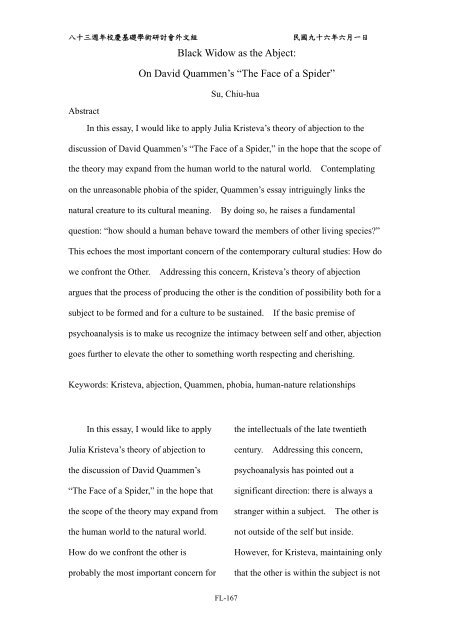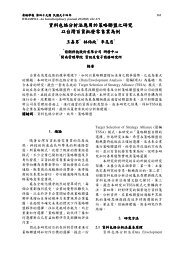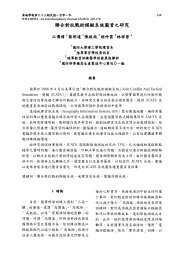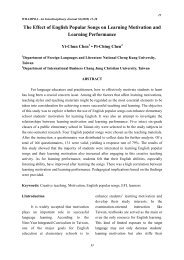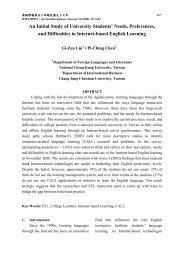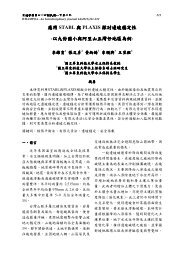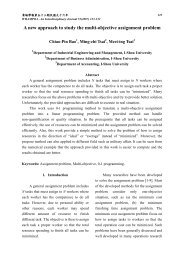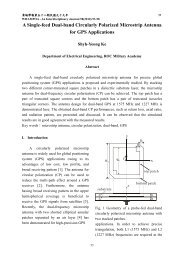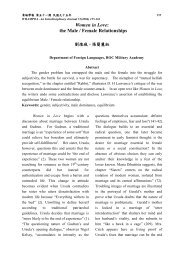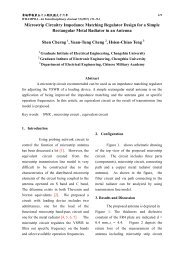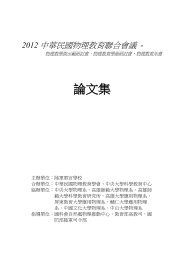On David Quammen's “The Face of a Spider”
On David Quammen's “The Face of a Spider”
On David Quammen's “The Face of a Spider”
You also want an ePaper? Increase the reach of your titles
YUMPU automatically turns print PDFs into web optimized ePapers that Google loves.
八十三週年校慶基礎學術研討會外文組 民國九十六年六月一日<br />
Abstract<br />
Black Widow as the Abject:<br />
<strong>On</strong> <strong>David</strong> Quammen’s <strong>“The</strong> <strong>Face</strong> <strong>of</strong> a <strong>Spider”</strong><br />
Su, Chiu-hua<br />
In this essay, I would like to apply Julia Kristeva’s theory <strong>of</strong> abjection to the<br />
discussion <strong>of</strong> <strong>David</strong> Quammen’s <strong>“The</strong> <strong>Face</strong> <strong>of</strong> a Spider,” in the hope that the scope <strong>of</strong><br />
the theory may expand from the human world to the natural world. Contemplating<br />
on the unreasonable phobia <strong>of</strong> the spider, Quammen’s essay intriguingly links the<br />
natural creature to its cultural meaning. By doing so, he raises a fundamental<br />
question: “how should a human behave toward the members <strong>of</strong> other living species?”<br />
This echoes the most important concern <strong>of</strong> the contemporary cultural studies: How do<br />
we confront the Other. Addressing this concern, Kristeva’s theory <strong>of</strong> abjection<br />
argues that the process <strong>of</strong> producing the other is the condition <strong>of</strong> possibility both for a<br />
subject to be formed and for a culture to be sustained. If the basic premise <strong>of</strong><br />
psychoanalysis is to make us recognize the intimacy between self and other, abjection<br />
goes further to elevate the other to something worth respecting and cherishing.<br />
Keywords: Kristeva, abjection, Quammen, phobia, human-nature relationships<br />
In this essay, I would like to apply<br />
Julia Kristeva’s theory <strong>of</strong> abjection to<br />
the discussion <strong>of</strong> <strong>David</strong> Quammen’s<br />
<strong>“The</strong> <strong>Face</strong> <strong>of</strong> a Spider,” in the hope that<br />
the scope <strong>of</strong> the theory may expand from<br />
the human world to the natural world.<br />
How do we confront the other is<br />
probably the most important concern for<br />
FL-167<br />
the intellectuals <strong>of</strong> the late twentieth<br />
century. Addressing this concern,<br />
psychoanalysis has pointed out a<br />
significant direction: there is always a<br />
stranger within a subject. The other is<br />
not outside <strong>of</strong> the self but inside.<br />
However, for Kristeva, maintaining only<br />
that the other is within the subject is not
八十三週年校慶基礎學術研討會外文組 民國九十六年六月一日<br />
enough. Her theory <strong>of</strong> abjection argues<br />
more radically that the process <strong>of</strong><br />
producing the other is the condition <strong>of</strong><br />
possibility for a subject to be formed.<br />
If the basic premise <strong>of</strong> psychoanalysis is<br />
to make us recognize the intimacy<br />
between self and other, abjection goes<br />
further to elevate the other to something<br />
worth respecting and cherishing.<br />
While Kristeva’s discussion <strong>of</strong><br />
abjection focuses on the anti-Semitism<br />
<strong>of</strong> the western world, here I will try to<br />
apply it to the attitude <strong>of</strong> human beings<br />
toward other species, especially those<br />
which are despised and abhorred, the<br />
vermin. In <strong>“The</strong> <strong>Face</strong> <strong>of</strong> a Spider,”<br />
with the subtitle “Eyeball to Eyeball<br />
with the Good, the Bad, and the Ugly,”<br />
Quammen raises a fundamental question:<br />
“How should a human behave toward<br />
the members <strong>of</strong> other living species” (3,<br />
5). More accurately speaking, what<br />
kind <strong>of</strong> attitude should we assume<br />
toward the non-human species which are<br />
ugly and detestable to us, ones which<br />
arouse feeling <strong>of</strong> disgust and revulsion?<br />
FL-168<br />
The incident depicted in the essay is<br />
simple: facing a hundred newly hatched<br />
black widows spreading over his study,<br />
the author tried to figure out what he<br />
should do to them. Holding Darwinian<br />
view that survival has to do with<br />
“ruthless squashing and gobbling” (6), 1<br />
Quammen dismissed the idea <strong>of</strong><br />
“ahimsa” (6), a Jainist teaching <strong>of</strong><br />
no-killing, and suggested a direct<br />
confrontation with the radical otherness<br />
the black widows stand for. In the<br />
following passages, I will argue that the<br />
spiders <strong>of</strong> Quammen correspond to<br />
Kristeva’s conception <strong>of</strong> the abject in<br />
that the primal fear aroused by them is<br />
rooted in human being’s impulsion to<br />
reject and expel the remains <strong>of</strong> natural<br />
matrix which homo sapiens is born into.<br />
At the very beginning <strong>of</strong> the<br />
Powers <strong>of</strong> Horror, Kristeva gives<br />
definition to abjection: <strong>“The</strong>re looms,<br />
within abjection, one <strong>of</strong> those violent,<br />
1 As to the contribution, or damage, the<br />
Darwinian view <strong>of</strong> nature has made to the ethics<br />
regarding humans and nature is a tremendous<br />
issue, which cannot be dealt with here.
八十三週年校慶基礎學術研討會外文組 民國九十六年六月一日<br />
dark revolts <strong>of</strong> being, directed against a<br />
threat that seems to emanate from an<br />
exorbitant outside or inside, ejected<br />
beyond the scope <strong>of</strong> the possible, the<br />
tolerable, the thinkable” (1). Within<br />
abjection lies a potential for revolt,<br />
threatening to subvert the existence <strong>of</strong><br />
the subject from both inside and outside.<br />
For a subject to be formed, part <strong>of</strong> me<br />
must be expelled with violence and<br />
aggressivity. This turbulent movement<br />
<strong>of</strong> ejection and banishment is what<br />
Kristeva calls the “abjection.” The<br />
formation <strong>of</strong> subject is thus based on the<br />
indistinguishable border between inside<br />
and outside, for, had it not been for the<br />
rejected inside which has been pushed<br />
out, there would never have been a<br />
subject. The formation <strong>of</strong> the I is<br />
always accompanied by violence against<br />
the other, which is bred within me.<br />
The part <strong>of</strong> me which is rejected, the<br />
abject, has nothing to do with its essence,<br />
but with the security <strong>of</strong> identity, border<br />
and regulation. Therefore, abject<br />
should not be confused with object. It<br />
FL-169<br />
“has only one quality <strong>of</strong> the object—that<br />
<strong>of</strong> being opposed to I” (1). While<br />
object settles me in the context <strong>of</strong><br />
meaning, abject “draws me toward the<br />
place where meaning collapses” (2).<br />
Those heterogeneous elements which<br />
elude symbolic regulation fail to provide<br />
meaning, and therefore should be<br />
expelled. Different from Freud and<br />
Lacan, who believed that the formation<br />
<strong>of</strong> the subject is induced through<br />
Oedipus triangle, Kristeva contends that<br />
the process <strong>of</strong> emanation and rejection,<br />
the mechanism <strong>of</strong> “exclusion” (6),<br />
happens even earlier than the time when<br />
father intervenes in mother-child<br />
symbiosis: “Abjection preserves what<br />
existed in the archaism <strong>of</strong> pre-objectal<br />
relationship, in the immemorial violence<br />
with which a body becomes separated<br />
from another body in order to be” (10).<br />
The act <strong>of</strong> pushing away mother’s breast<br />
itself is already a symbolic gesture;<br />
hence, the birth <strong>of</strong> a subject is not<br />
registered through the acceptance <strong>of</strong> the<br />
Name <strong>of</strong> the Father, but through the
八十三週年校慶基礎學術研討會外文組 民國九十六年六月一日<br />
abjection <strong>of</strong> maternal body and the<br />
related defilement. Abject, no matter<br />
what is pinned down to it, implies a<br />
primal fear toward femininity and<br />
corporeality. Further, the process <strong>of</strong><br />
abjection is an ongoing process,<br />
continuing throughout human life.<br />
Whenever the subject feels insecure<br />
about his own identity, he has the urge to<br />
push away the abject.<br />
More importantly, this urge <strong>of</strong><br />
pushing away abject does not only<br />
contribute to the figuration <strong>of</strong> the I but<br />
also the establishment <strong>of</strong> human<br />
civilization. According to Kristeva,<br />
every culture has its own method <strong>of</strong><br />
dealing with the sense <strong>of</strong> abjection.<br />
She argues that some religious rituals,<br />
for instance, can be regarded as the<br />
performances <strong>of</strong> abjection. Through<br />
the rituals <strong>of</strong> banishing the unclean, the<br />
stability <strong>of</strong> a culture is sustained. In<br />
the modern era, when religion loses its<br />
throne, the act <strong>of</strong> writing ascends to the<br />
rescue <strong>of</strong> cultural security. “In a world<br />
in which the Other has collapsed, the<br />
FL-170<br />
aesthetic task—a descent into the<br />
foundations <strong>of</strong> the symbolic<br />
construct—amounts to retracing the<br />
fragile limits <strong>of</strong> the speaking being,<br />
closest to its dawn, to the bottomless<br />
‘primacy’ constituted by primal<br />
repression” (18). The linkage between<br />
abjection and cultural phenomena makes<br />
Kristeva’s discussion especially<br />
productive, since objects excluded and<br />
despised can be understood through its<br />
cultural context. It may help explain<br />
why some objects are treated as abject in<br />
certain cultures but not in the others. It<br />
is not the essence <strong>of</strong> the objects that<br />
determines people’s attitude. The urge<br />
<strong>of</strong> abjection is usually aroused by the<br />
chaotic primitive elements threatening to<br />
subvert the foundation <strong>of</strong> the symbolic<br />
construction. For the establishment <strong>of</strong><br />
a cultural subject, the banishment <strong>of</strong><br />
primitive maternal elements is<br />
necessary.<br />
Abjection is manifested in a variety<br />
<strong>of</strong> cultural milieux, some cruel, some<br />
artistic, depending on how the cultural
八十三週年校慶基礎學術研討會外文組 民國九十六年六月一日<br />
being decides to deal with the abject.<br />
In this essay I would like to put my<br />
emphasis on the phobia <strong>of</strong> spider<br />
described in Quammen’s <strong>“The</strong> <strong>Face</strong> <strong>of</strong> a<br />
Spider.” Seeing nearly a hundred black<br />
widow spiders strewing over his desk,<br />
Quammen wrote, “It was a vision <strong>of</strong><br />
ghastly, breathtaking beauty, and it<br />
brought on me a wave <strong>of</strong> nausea” (3).<br />
The sight <strong>of</strong> a hundred newly hatched<br />
baby spiders arouses a feeling <strong>of</strong> both<br />
indescribable attraction and revulsion,<br />
the sense <strong>of</strong> the abjection. Subject is<br />
drawn to it, but has to reject it.<br />
Obviously, spider is the abject, which is<br />
feared and despised not because <strong>of</strong> the<br />
danger it poses to man but because <strong>of</strong> its<br />
radical otherness. As Quammen<br />
observes, while snakes and mosquitoes<br />
cause tremendous death tolls every year,<br />
the black widow is relatively harmless.<br />
Compared to other non-human species,<br />
such as snail, bull snake, or carp, the<br />
feature <strong>of</strong> a spider is distinguished by its<br />
radical alterity: <strong>“The</strong> face <strong>of</strong> a spider is<br />
unlike anything else a human will ever<br />
FL-171<br />
see. The word ‘ugly’ doesn’t even<br />
begin to serve. ‘Grotesque’ and<br />
‘menacing’ are too mild. The only<br />
adequate way <strong>of</strong> communicating the<br />
effect <strong>of</strong> a spiderly countenance is to<br />
warn that it is ‘very different,’ and then<br />
<strong>of</strong>fer a photograph” (7). Even so, when<br />
one confronts the face <strong>of</strong> a spider, words<br />
fail to communicate. It draws the<br />
subject “toward the place where the<br />
meaning collapses” (Kristeva 2).<br />
What makes black widow spider an<br />
abject? The cultural inscription, rather<br />
than the essence <strong>of</strong> the spider may<br />
answer the question. In western culture,<br />
the black widow spider represents an<br />
idée fixe that the female spider gnaws<br />
the male <strong>of</strong>f after copulation. This<br />
insect behavior is appalling in human<br />
eye. Intriguingly, it gears to the fear <strong>of</strong><br />
the female body in the patriarchal<br />
society. The naming <strong>of</strong> the “black<br />
widow” reveals human effort to capture<br />
the unimaginable and unthinkable<br />
through the symbolic web, which is<br />
functioned under the Name <strong>of</strong> the Father.
八十三週年校慶基礎學術研討會外文組 民國九十六年六月一日<br />
The absence <strong>of</strong> the father, which the<br />
word “widow” implies, paradoxically<br />
strengthens the potency <strong>of</strong> the Name <strong>of</strong><br />
the Father and fortifies the incest taboo.<br />
Since obtaining the desired object, the<br />
mother, means the death <strong>of</strong> the subject,<br />
the exclusion <strong>of</strong> everything related to<br />
maternal status is necessary. Therefore,<br />
the phobia <strong>of</strong> the black widow involves<br />
a deep fear toward maternity and<br />
femininity. However, I would like to<br />
argue that this fear cannot be adequately<br />
explicated through the working <strong>of</strong> the<br />
symbolic. The fear <strong>of</strong> the mother roots<br />
deep in the primal relation between<br />
mother and child, the necessity <strong>of</strong> the<br />
child to reject the part <strong>of</strong> itself that<br />
belongs to the (m)other--abjection.<br />
In <strong>“The</strong> <strong>Face</strong> <strong>of</strong> a Spider,”<br />
Quammen associates the idea <strong>of</strong> the<br />
mother with the black widow. The<br />
reason why there were a hundred baby<br />
spiders frolicking on his desk was that a<br />
pregnant female black widow had<br />
woven a net and waited for the eggs to<br />
be hatched in his study. “…[S]he had<br />
FL-172<br />
gotten pregnant. She had laid her eggs<br />
into a silken egg sac the size <strong>of</strong> a Milk<br />
Dud and then protected that sac<br />
vigilantly, keeping it warm, fending <strong>of</strong>f<br />
any threats, as black widow mothers do”<br />
(4). Pregnancy, as Elizabeth Grosz has<br />
pointed out, is also like abjection in that<br />
it is a “borderline phenomen[a], blurring<br />
yet producing one identity and an<br />
another” (95). If the symbolic ensures<br />
the stability <strong>of</strong> identity, pregnancy, then,<br />
challenges the validation <strong>of</strong> the<br />
self-enclosed identity through<br />
corporeality. This explains why in a<br />
patriarchal society things related to<br />
women’s ability <strong>of</strong> giving birth are<br />
usually covered by mysteries and taboos.<br />
Grotz goes further to maintain that the<br />
female body capable <strong>of</strong> generating<br />
another body reminds human subjects<br />
their root in the natural world. “Like<br />
the abject, maternity is the splitting,<br />
fusing, merging, and fragmenting <strong>of</strong> a<br />
series <strong>of</strong> bodily processes beyond the<br />
will or control <strong>of</strong> the subject. The<br />
woman-mother finds that it is not her
八十三週年校慶基礎學術研討會外文組 民國九十六年六月一日<br />
identity or value as a woman which<br />
maternity affirms, but her position as<br />
natural or as a hinge between nature and<br />
culture” (96). Abjection, the child’s<br />
movement <strong>of</strong> pushing away the mother<br />
in order to distinguish the self from the<br />
other, is also the cultural subject’s<br />
rejection <strong>of</strong> his own corporeality and<br />
mortality for the purpose <strong>of</strong> establishing<br />
a barrier between nature and culture.<br />
Therefore, if Anna Smith is correct by<br />
saying that “[p]hobia is a condition<br />
where its subject dreads maternal fusion,<br />
but equally fears separation from the<br />
mother” (158), the phobia <strong>of</strong> the black<br />
widow spider can be understood as<br />
subject’s dual dreads <strong>of</strong> fusion with and<br />
separation from nature.<br />
Abjection is sometimes manifested<br />
through the fear <strong>of</strong> pollution.<br />
Employing anthropologist Mary<br />
Douglas’s theorization <strong>of</strong> defilement,<br />
Kristeva notes that the desire <strong>of</strong> the<br />
patriarchal culture is to sustain the<br />
border <strong>of</strong> the sex. She indicates that an<br />
object is regarded as an abject not<br />
FL-173<br />
because <strong>of</strong> its essence but because <strong>of</strong> its<br />
potential to harass the border.<br />
“…[F]ilth is not a quality in itself, but it<br />
applies only to what relates to a<br />
boundary and, more particularly,<br />
represents the object jettisoned out <strong>of</strong><br />
that boundary, its other side, a margin.”<br />
(Original italics; Kristeva 69). Objects<br />
exemplified as abject here are things that<br />
might cause pollution and contamination,<br />
such as menstrual blood and feces.<br />
Both <strong>of</strong> menstrual blood and feces<br />
signify the alternative power to the<br />
father—“Maternal authority” (Kristeva<br />
72). The defense against these objects’<br />
pollution refers to the watertight guard<br />
for sexual difference in patriarchal<br />
societies, suggesting the fear toward<br />
women and their power <strong>of</strong> procreation.<br />
Despite the fact that reproduction is<br />
elemental to the survival <strong>of</strong> a society,<br />
women’s ability to give birth is abhorred<br />
and should be taken under vigilant<br />
control. Kristeva observes, “Fear <strong>of</strong><br />
the archaic mother turns out to be<br />
essentially fear <strong>of</strong> her generative power.
八十三週年校慶基礎學術研討會外文組 民國九十六年六月一日<br />
It is this power, a dreaded one, that<br />
patrilineal filiation has the burden <strong>of</strong><br />
subduing” (77). In the society where<br />
birth control is more in need, the more<br />
prohibitions are set against pollution and<br />
defilement. To the contrary, if a people<br />
live on abundant resources, one can<br />
hardly find any taboos or prohibitions<br />
against defilement (78). The fear<br />
toward the power <strong>of</strong> procreation turns<br />
into the obligation to strictly prevent<br />
pollution. In order to sustain the<br />
symbolic system, it is necessary to fend<br />
<strong>of</strong>f everything related to the maternal,<br />
the natural, and the chaotic.<br />
In Quammen’s essay, the black<br />
FL-174<br />
widow spider appalls man because it<br />
seems to possess a mighty power <strong>of</strong><br />
procreation, so mighty that the fragile<br />
structure <strong>of</strong> human sphere are threatened<br />
to be devoured. They are the ones<br />
which “disturb identity, system and<br />
order, disrupting the social boundaries<br />
demanded by the symbolic. [They]<br />
respect no definite positions, or rules,<br />
boundaries, or socially imposed limits”<br />
(Grotz 90). In Tucson, the city where<br />
Quammen lived, “black widows breed<br />
like rabbits and prosper like<br />
cockroaches” (3). They occupied a<br />
space rapidly, turning the study into a<br />
spider hatchery:<br />
…[F]ifty or sixty <strong>of</strong> them had reached the lampshade and rappelled back<br />
down on dainty silk lines, leaving a net <strong>of</strong> gossamer rigging between the<br />
lamp and the Darwin book…that set on the desk. Some dozen others<br />
had already managed dispersal flights, letting out strands <strong>of</strong> buoyant silk<br />
and ballooning away on rising air, as spiderlings do—in this case<br />
dispersing as far as the bookshelves. (4-5)<br />
As abject, black spiders threaten to<br />
pollute the civilized world—epitomized<br />
here by the study filled up with books.<br />
The black widow spiders, with the<br />
prodigious power <strong>of</strong> reproduction, pose<br />
a threat to subvert the fragile system <strong>of</strong><br />
human civilization.<br />
In Tucson, it is the black widow<br />
which assumes the position <strong>of</strong> abject,<br />
while every society, especially those<br />
highly civilized and populated ones,<br />
assignes certain non-human species as
八十三週年校慶基礎學術研討會外文組 民國九十六年六月一日<br />
its abject. As Huw Griffiths, Ingrid<br />
Poulter and <strong>David</strong> Sibley have argued,<br />
people’s attitudes toward the non-human<br />
species vary, depending on “their<br />
placing within a particular cosmology”<br />
(58). Those treated as pests are<br />
“animals which transgress the boundary<br />
between civilization and nature, or<br />
between public and private, which do<br />
not stay in their allotted space” (60). In<br />
other words, they are the abject. They<br />
stimulate the “feelings <strong>of</strong> discomfort or<br />
even nausea which we try to distance<br />
from the self, the group and associated<br />
spaces (but which we can never banish<br />
from the psyche)” (60). These<br />
animals/insects/plants are usually<br />
remarked by their vigorous fertility, such<br />
as rats, pigeons, stray dogs and feral cats,<br />
which, in the eyes <strong>of</strong> the city<br />
administrators, threaten to pollute the<br />
rationalized city space and subvert the<br />
structure <strong>of</strong> civilization which has to be<br />
maintained warily. The dirt they make<br />
might deteriorate city hygiene; the howls<br />
in the breeding season pierce through<br />
FL-175<br />
tranquil orderly night; their<br />
uncontrollable movement transgresses<br />
the limits between the domestic and the<br />
public. In short, they disturb “system<br />
and order, disrupting the social<br />
boundaries demanded by the symbolic,”<br />
and showing no respect to “rules,<br />
boundaries, or socially imposed limits.”<br />
What abjection involves are not<br />
only the relationships between self and<br />
object, but also that between self and the<br />
Other, the Symbolic. The impulsion to<br />
reject the “part <strong>of</strong> me” which reminds us<br />
<strong>of</strong> the fact that we are part <strong>of</strong> nature is<br />
the way to establish civilization.<br />
“…[A]bject and abjection are my<br />
safeguards. The primers <strong>of</strong> my<br />
culture” (Kristeva 2). Although it<br />
cannot be denied that human beings are<br />
part <strong>of</strong> nature, we have to draw a line<br />
between us and nature in order to<br />
survive, that is to say, to occupy a niche<br />
within natural world. As Terry<br />
Eagleton argues, “[b]ecause we are all<br />
born prematurely…our nature contains a<br />
yawning abyss into which culture must
八十三週年校慶基礎學術研討會外文組 民國九十六年六月一日<br />
instantly move, otherwise we would<br />
quickly die” (my italics)(73). The<br />
paradox that culture which keeps us<br />
alive in natural world demands a violent<br />
and aggressive rejection toward nature is<br />
brilliantly illustrated in Kristeva’s theory<br />
<strong>of</strong> abjection. However, what is<br />
especially enlightening in her theory is<br />
that she does not justify violence and<br />
aggressivity in the name <strong>of</strong> abjection.<br />
She goes further to suggest that<br />
abjection needs to be sublimated. And<br />
the sublimation <strong>of</strong> abjection, the<br />
alternative to treat the impulsion <strong>of</strong><br />
abjection in a non-violent way, is the<br />
creation <strong>of</strong> literature, that is, the<br />
employment <strong>of</strong> the symbolic to deal<br />
with the inassimilable and the<br />
unacceptable. “…[T]he subject <strong>of</strong><br />
abjection is eminently productive <strong>of</strong><br />
culture. Its symptom is the rejection<br />
and reconstruction <strong>of</strong> languages”<br />
(Kristeva 45). If what distinguishes<br />
human body from lifeless objects and<br />
animals is the capacity to make use <strong>of</strong><br />
language to communicate with each<br />
FL-176<br />
other in an extremely complicated way<br />
(Eagleton 72), the sublimation <strong>of</strong><br />
abjection, the production <strong>of</strong> cultural<br />
works, marks the watershed between<br />
human beings and animals. The moral<br />
here lies in choosing consciously the<br />
non-violent way, i.e., writing, to deal<br />
with the abject.<br />
Quammen’s question <strong>of</strong> “[h]ow<br />
should a human behave toward the<br />
members <strong>of</strong> other living species” can be<br />
paraphrased as follows: how should a<br />
speaking subject behave toward the<br />
species which are treated as abject? If<br />
abjection <strong>of</strong> nature is fundamental for<br />
civilization, how do we find a less<br />
aggressive way to co-exist, or, at least<br />
tolerate the natural other? If the violent<br />
banishment <strong>of</strong> everything related to<br />
nature is necessary for the formation <strong>of</strong> a<br />
cultural subject, how do we sublimate<br />
the violence? Quammen’s advice is to<br />
resort to both the symbolic and the<br />
imaginary. Before making eye contact<br />
with the spider, one must first be warned<br />
(through words) <strong>of</strong> its extreme
八十三週年校慶基礎學術研討會外文組 民國九十六年六月一日<br />
difference and then <strong>of</strong>fered an image.<br />
During the eye contact, he suggests to<br />
repeat the mantra: “This is some<br />
FL-177<br />
mother’s darling, this is some mother’s<br />
child” (7). After the preparations, he<br />
looks into a spider’s face:<br />
I only know that, when I make eye contact with on, I feel a deep physical<br />
shudder <strong>of</strong> revulsion, and <strong>of</strong> fear, and <strong>of</strong> fascination; and I reminded that<br />
the human style <strong>of</strong> face is only one accidental pattern among many, some<br />
<strong>of</strong> the others being quite drastically different. I remember that we aren’t<br />
alone. I remember that we are the norm <strong>of</strong> goodness and comeliness<br />
only to ourselves. I wonder about how ugly I look to the spider. (8)<br />
The feeling <strong>of</strong> revulsion, fear and<br />
fascination—sense <strong>of</strong> abjection—is<br />
followed by the realization that human<br />
being is the arbitrator only <strong>of</strong> the human<br />
world, which is located in a larger<br />
matrix.<br />
Even so, he honestly admits that the<br />
final decision he made with the hundred<br />
baby spiders was to exterminate them all.<br />
His massacre <strong>of</strong> a hundred spiders seems<br />
to be a “glaring contradiction” (5) to his<br />
promotion <strong>of</strong> “eye contact” with<br />
non-human species. The ethics related<br />
to killing other species is too large an<br />
issue to be dealt with in this paper.<br />
Here I would like to put aside the moral<br />
debates on killing and suggest a<br />
psychoanalytic reading <strong>of</strong> Quammen’s<br />
solution. The extermination <strong>of</strong> the<br />
spiders is performed not without the<br />
subject knowing <strong>of</strong> what he is doing.<br />
The movement <strong>of</strong> abjection here is not<br />
an unreflective violent attack but a<br />
conscious act with the knowledge <strong>of</strong><br />
how subject is related to the Other.<br />
The aggressivity and violence<br />
accompanied the constitution <strong>of</strong> the<br />
subject are laid down into words. The<br />
application <strong>of</strong> Kristeva’s theory <strong>of</strong><br />
abjection to <strong>“The</strong> <strong>Face</strong> <strong>of</strong> a <strong>Spider”</strong> may<br />
not answer Quammen’s question <strong>of</strong> how<br />
man should behave toward other species.<br />
Nevertheless, it may at least point out a<br />
direction for us to meditate on how the<br />
internal impulses determine the<br />
relationships between self and other,<br />
humans and nature.
八十三週年校慶基礎學術研討會外文組 民國九十六年六月一日<br />
Works Cited<br />
Eagleton, Terry. The Illusions <strong>of</strong><br />
Postmodernism. Oxford:<br />
Blackwell, 1996.<br />
Griffiths, Huw, Ingrid Poulter, and<br />
<strong>David</strong> Sibley. “Feral Cats in the<br />
City.” Animal Spaces, Beastly<br />
Places: New Geographies <strong>of</strong><br />
Human-animal Relations. Ed.<br />
Chris Philo and Chris Wilbert.<br />
London: Routledge, 2000. 56-70.<br />
Grosz, Elizabeth. <strong>“The</strong> Body <strong>of</strong><br />
Signification.” Abjection,<br />
Melancholia and Love: The Work <strong>of</strong><br />
Julia Kristeva. Ed. John Fletcher<br />
and Andrew Benjamin. London:<br />
Routledge, 1990. 80-103.<br />
Kristeva, Julia. Powers <strong>of</strong> Horror: An<br />
FL-178<br />
Essay on Abjection. Trans. Leon<br />
S. Roudiez. New York: Columbia<br />
UP, 1982.<br />
Quammen, <strong>David</strong>. <strong>“The</strong> <strong>Face</strong> <strong>of</strong> a<br />
Spider: Eyeball to Eyeball with the<br />
Good, the Bad, and the Ugly.”<br />
The Flight <strong>of</strong> the Iguana: A<br />
Sidelong View <strong>of</strong> Science and<br />
Nature. New York: Touchstone<br />
Book, 1988. 3-9.<br />
Smith, Anna. Julia Kristeva: Readings<br />
<strong>of</strong> Exile and Estrangement.<br />
Houndmills: MacMillan, 1996.
八十三週年校慶基礎學術研討會外文組 民國九十六年六月一日<br />
由賤斥理論討論大衛.奎曼的〈蜘蛛的臉〉<br />
蘇秋華<br />
中文摘要:<br />
本文試圖以克莉絲蒂娃的賤斥理論來討論大衛.奎曼的〈蜘蛛的臉〉,希望能藉<br />
此將賤斥理論的運用範圍從人類世界擴大到自然界。奎曼的散文巧妙地從自然界<br />
的生物談到其文化意涵,作者提出了一個最根本的問題:「人類在面對其他物種<br />
時究竟該展現何種行動?」這個問題呼應了當代文學研究最重要的關懷:我們要<br />
如何面對他者?針對這個問題,克莉絲蒂娃的賤斥理論所說明的便是,產出他者<br />
的過程乃是形構主體和維繫文化的必要條件。如果精神分析的基本前提是使我們<br />
體認到自我和他者的親密性,賤斥理論則進一步提昇他者的地位,成為值得被敬<br />
重並珍惜的對象。<br />
關鍵字:克莉絲蒂娃、賤斥、奎曼、恐懼症、人與自然的關係<br />
FL-179


